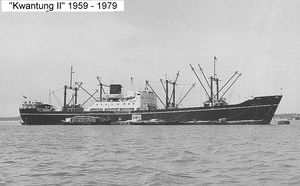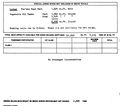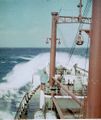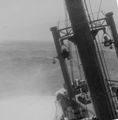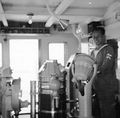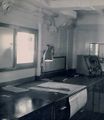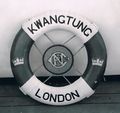Kwangtung II
Sister ship of the C Class ship Chungking IV. Mates & Engineers cabins now extended to full width of the ship. The funnel is slightly shorter than in the "C class"
Contents
History
March 1965. Chartered to the Crusader Shipping Co. (Jointly owned by:- New Zealand Shipping Co., Port Line, Shaw,Savill & Albion, & Blue Star) for the New Zealand - Japan service. Blue Star as managers. Renamed Norman I.
March 1966. Reverted to the name Kwangtung.
July 1977. Transferred to the subsidiary Taikoo Navigation Co.
Jan 1979. Sold to Johnson & Co. (Asia) Ltd., Panama. Renamed California.
1980. Transferred to Gordon Navigation Co. S.A., Panama.
1983. Transferred to Juniper Shipping Co. S.A., Panama. Renamed Wayfull.
1983. Scrapped in Shanghai.
Service
Events / Stories
Ian David Goddard, who was 3rd mate at the time, describes this voyage from Kong Kong to Freemantle in early 1961.
Following a dawn arrival in Singapore and our clearance in the Eastern Roads, we proceeded alongside to discharge in Empire Dock. Any thoughts of a good run ashore were quickly dashed when we found that after discharging our Singapore cargo we only had some small tonnages to load for Indonesia and Fremantle before being scheduled to sail again that evening for Djakarta. There was barely enough time to squeeze in a quick trip to the Post Office after lunch to mail off letters home, followed by a swim in the pool at the Seamen’s Club, before returning aboard for my cargo watch.
We sailed again late evening and wearily headed across to the Rhio Straits in Indonesian waters to the south of Singapore. Just after midnight the 4th Engineer came up off watch to find the sooty black apparition of a stowaway in the bathroom, not a sight for the faint hearted. Some hours before sailing, the Agent had warned us that an English student, who had previously stowed away on another ship, had been sighted in the dock area. A cursory search had been carried out before sailing but after a full days cargo work in the tropical sun, nobody had much time or inclination to crawl through every nook and cranny on the ship, - an almost impossible task at the best of times, as any Customs Officer could tell you. Once he had been cleaned up, we found we had indeed acquired the notorious student, who had somehow managed to hide away up the funnel where he became rapidly kippered once the ship got under way. He received little sympathy, particularly from the Old Man who was furious with this weedy specimen, a Liverpudlian, who was bumming his way around the world with scant understanding or care about the trouble he was causing. The Mate was ordered to ensure our unwelcome guest was given hard labour and every unsanitary job imaginable, plus a few more never previously imagined. Protesting bleats about human rights (he must have been a law student) were totally ignored, so hard unremitting labour was his miserable lot, together with the threat that lack of productivity would be met with a diet of bread and water. The Old Man, who as a wartime prisoner of the Japanese had been forced to work in the coalmines of Hokkaido, quite understandably considered the stowaway was being treated with comparative leniency.
The passage down through the islands to Djakarta was an interesting one with ample reef hopping to enliven watchkeeping, plus transits of the Rhio and Banka Straits to negotiate, - it certainly boosted the nautical skills. The call at Djakarta had only nuisance value for us as the tonnage for discharge was not large. Even if time had permitted, it was not worth risking a trip ashore where our presence would not have been welcome as at that time Britain and Indonesia were at loggerheads over a territorial dispute in Borneo which had recently degenerated into armed conflict along the border.
A short trip along the coast to Tjeribon followed our departure from Djakarta. This was for an even smaller capful of cargo unloaded into barges at the anchorage. We probably spent more time passing across the standard bribes of cigarettes and alcohol to the local port officials so we could work the cargo, than we actually spent unloading it. Such was the system in those days, but one that was impossible to bypass. Once clear of Tjeribon, we weaved our way eastwards along the north Java coast through groups of fishing boats and inter-island traders, all colourful craft with high prows and mostly under sail. Like their Chinese counterparts, many had eyes painted each side of the bow to avoid evil spirits. Also like the Chinese, their favourite manoeuvre appeared to be passing as close as possible across the bows of an approaching ship so that any following evil spirits would be cut off and transfer their attention to the ship. They appeared to be largely immune to any recognised form of seafaring rules of the road and were a peril of themselves as well as any other craft in the area. The Mate, J.D.Holden, an old hand in these waters, was convinced that taking avoiding action only encouraged this silly behaviour and confused all other craft in the vicinity. His answer to the problem was to plough straight on and rely on everyone else realising the dangers of not keeping out of his way. It seemed to work quite well as our score in cutting off evil spirits was not as high as the screams and shouts that followed our progress along the coast. This interesting form of watchkeeping was left astern when we passed down through the Lombok Straits between Java and Bali to head southwards for Australia.
Our first port, Point Samson, a flyspeck on the map of North Western Australia, was a desolate spot, a jetty fringed by reefs set amid a dun coloured landscape shimmering in the heat. Its only claim to fame was a 25 feet rise and fall of tide which meant we had to constantly keep an eye on our mooring lines. From the boat deck we could look down on the activity along the jetty at high tide yet several hours later our view was restricted to barnacle encrusted piles under the jetty. The only building in sight (at high tide) was the iron roof of a shed half hidden behind the dunes at the head of the wharf. I nearly went there once to have a look at the settlement but was driven back to the ship by the unremitting attention of several million flies.
The nearest town, Cossack, was some miles away, consequently whilst in port, Kwangtung became the watering hole for the locals that appeared from who knows where, to load our cargo. Without large volumes of beer to quench their apparently insatiable thirsts, no cargo work was done. Our Chinese Chief Steward, familiar with the run and the need to lubricate the throats in Point Samson, had stocked up with crates of beer in Shanghai, a dubious brew with the saving grace of being disgustingly cheap. This liquid manna from heaven was consumed in great quantities by the uncomplaining Australians before, during and after working cargo. It was a useful arrangement, for the ship loaded her cargo, the wharfies belched happily and Steward made a fortune. The cargo loaded at Port Samson was bagged blue asbestos, usually several hundred tons of the stuff, that came up by road train from Wittenoom Gorge, a mine somewhere in the middle of nowhere, or perhaps even beyond it!
24/1/61. ”Why on earth they export asbestos from here I don’t know, they ought to keep it for their own use. The temperature yesterday was 109F.”
Our port stay was normally less than 24 hours but it did give us with the opportunity to get the motor lifeboat into the water and go off fishing around the reefs. This was always popular with both officers and crew, for the sea simply teemed with fish just waiting to be caught on our hand lines. We always returned with a good haul and once we even caught a rather upset turtle, which as a protected species, had to be cooked and eaten with indecent dispatch, to destroy the evidence. For any gourmets, I can confirm it was absolutely beautiful in a slow casserole with red wine. Occasionally the wharfinger would take a couple of officers out at night in his truck to shoot kangaroos, which again were an exotic addition to the Kwangtung’s menu. It must be said however, that most of these raids on the local wildlife took place on subsequent trips as in the midst of my introduction to Point Samson, the wharfinger came pelting down the jetty on his bicycle to warn us of an approaching cyclone. We put to sea with indecent haste so that Kwangtung could stand well clear of the coast and hopefully dodge the worst of the weather. The former we managed, the latter we didn’t. For the next two days we plunged through mountainous seas in a twilight of flying rain and spray accompanied by the deafening roar of wind and water. At times like that, a career back on the dustcart seemed an attractive option.
On the bridge we constantly used both wheel and main engines to keep the ship’s head up into the seas, for being half light the bows provided plenty of windage as they reared heavenwards climbing gigantic waves that reared up through the murk. Seconds later we would fall sickeningly into the watery valley of the following trough until the bows dug in to the next mountain of water, pushing us violently upwards again with the foredeck a seething mass of water and bursting spray. The Old Man spent the two days wedged in the corner of the wheelhouse looking increasingly haggard as the hours dragged on. For the Mates, watch keeping was purgatory but at least we could get away down to our cabin at the end of our watch, to wedge ourselves into our bunks where we could hang on and hope to sleep amid the crashing of various minor disasters in the ship around us. The motion was so violent that hot meals had to be replaced by sandwiches, allowing the cooks to escape being burnt alive in the galley and the stewards a chance to be seasick in peace.
25/1/61 “In the weather reports we were sending into Perth, we estimated the height of the waves was between 50 and 60 feet. Climbing up and down these monsters caused most of the damage for the whole bow was coming out of the water then falling back down with a crash and on occasions we were rolling about 40 degrees each way.”
Everyone forgot our stowaway locked in the hospital down aft on the poop, probably the worst possible place for motion and vibration on the ship. Just where the contents of his stomach managed to end up is better left to the imagination. When we finally emerged from the cyclone he was set to work hosing and washing the hospital out, starting with the deckhead. I would imagine that even the sight of an escort of two burly policemen at Fremantle when we finally arrived there, was a most welcome one. I would also imagine that the previous few days must have cured his stowaway habits once and for all.
As the weather eased and it became safe to venture out on deck again, the Mate and Bosun made an inspection tour around the hatches to check the damage. Kwangtung was half empty so many of the stows had collapsed. No1 hatch, up in the eyes of the ship was particularly bad as 300 tons of drummed molasses had broken loose in the tween decks, leaking their contents into the half empty lower hold down below. The hold looked like a treacle mine with sticky molasses everywhere and nearly a metre of the stuff oozing across the floor as the ship rolled. The engineers tried to pump the stuff out through the bilges but it was too thick for the pumps and they quickly clogged up. The Mate, ever an optimist, donned snorkel and flippers to “swim” down and check that the bilge lines were not blocked by debris. The Bosun and I who were hanging stickily onto the hold ladder, watched the Mate head down in the molasses with flippers flailing in the air. It occurred to us that he was not going anywhere very fast or achieving anything at all and may indeed be trouble into the bargain. So we hauled him out by his flippers, leaving his snorkel still firmly immersed somewhere in the goo, thereby ruining his chances of an entry in the record book for being the first person ever to drown in a sea of molasses. The Mate was suitably gracious and shouted the Bosun and I, as well as himself, several extremely large brandies on the yellow chit (company account).
The cyclone had demolished parts of the wharf at Point Samson as well as our nerves, so it was decided that we carry on down the coast to calmer waters and on to Fremantle.
Fremantle proved to be much quieter than anticipated for we found it to be in the grip of the type of senseless industrial action that was so common on the Australian waterfront in those days. The foremen stevedores had decided to form their own union which the waterside workers took exception to, so the wharfies wouldn’t accept any orders from the foremen and since they couldn’t work without those orders, they simply walked off the ship. It was claimed to be a protest not a strike but we still had to open up the hatches and get the ship ready to work cargo at the beginning of each of the three shifts. Small wonder we took a dim view of the whole affair! CNCo in Hong Kong instructed us to return to Singapore to discharge our Australian cargo, but this had to be rescinded when Lloyds refused to insure the ship which they classified as unseaworthy since No1 hold could not be pumped. Thus we were stuck in Fremantle, or rather Fremantle was stuck with us for our molasses became increasingly ripe with the passing days.
I cannot claim we were overly adverse to sitting around doing nothing, although our crew were gainfully employed chipping and painting the ship’s side. The Old Man lived in Perth so he was extremely happy, particularly as his daughter’s wedding had been scheduled to coincide with Kwangtung’s time in port. All the officers were invited to attend the reception in full uniform no doubt in the hope that we would act as mobile decorations, however we were under strict orders to not drink too much or molest the female guests. Naturally these were gleefully ignored.
6/2/61. “The reception was held on the boat deck under awnings decorated with fairy lights, which were novel surroundings for most of the guests more especially so since the ship is quite famous in connection with the cyclone. ……. I had to stand at the top of the gangway in No.10’s with a quartermaster in attendance to welcome the guests on board.”
Eventually of course all good things come to an end and work resumed when the kindergarten comedy on the waterfront ended. The wharfies of course demanded astronomical rates of pay for cleaning the treacle mine in No1 hold, - not that they actually did any of the work, this was undertaken by contracted cleaners. The wharfies simply sat around on deck in the sunshine reading newspapers and complaining about the smell during the 8 days it took for lesser mortals to clean up the mess. By the time this hatch was ready to load, all the other hatches had been emptied and back loaded again, consequently Kwangtung presented a rather ungainly sight, squatting on her stern with the bow nearly out of the water.
During this time, a New Zealand cruiser, HMNZS Royalist, spent several days berthed astern of us. We were treated to a daily display of naval pageantry on her quarterdeck with guards of honour for morning and evening “Colours”. Our crew, who has ringside seats on the poop, appeared particularly fascinated by these military machinations and soon started parading in their dungarees to copy the guard’s drill movements, marching up and down on our poop, presenting arms with canton brooms instead of rifles. This comedy appeared to impose some strain on naval discipline so our crew were ordered to desist after the Old Man received a frosty note from the cruiser’s commanding officer.
We loaded rather a mixed bag of general cargo in Fremantle, large tonnages of bagged flour, hops for the breweries in Singapore and Hong Kong, bales of wool, wet hides (very smelly), tinned food, fresh vegetables, frozen meat and refrigerated foodstuffs and last but by no means least live sheep.
Just prior to sailing, with our hatches battened down and derricks lowered, a convoy of livestock trucks arrived alongside to run 1500 sheep up a gangway and into pens on our decks. Most of the work was done by half a dozen sheep dogs who created far more activity and no doubt more productivity than a ship full of wharfies. All the sheep were aboard within two hours and off we sailed to the accompaniment much bleating and baaing as our deck cargo expressed its collective displeasure at the prospect of the sea cruise. The tugs were under strict orders not to blow their whistles as a Japanese freighter had recently lost most of her sheep during foggy weather off the coast. The Japanese blew their siren, the sheep took fright, one jumped over the side and the rest followed. Exit 1500 sheep! The sharks must have thought it was Christmas. The carriage of live sheep on deck was a regular feature of the West Australian trade, where most ships took them up to Singapore for extra revenue. In Singapore discharge was nearly as quick as the loading. A tame sheep, usually called the “Judas Sheep” was led aboard and allowed to mix with it’s Australian cousins for a few minutes before being led off again with our seafaring sheep tamely following him, or her, down the gangway to the wharf where they were then trucked off to their new abode at the abattoir.
The following were on board during this voyage:- Master :- Andrew Watson, 1st.Mate :- J.Holden, 2nd. Mate :- J.R.Rayner, 3rd mate :- I.Goddard, Chief Eng. :- R.W.Nickerson, 2nd. Eng. :- A.Myatt, 3rd. Eng. :- P.Cruze, 4th. Eng ;- W.H.C.de Ville, 5th. Eng. :- A.C.Thomson, 6th. Eng. :- Chan Sow Ting.
